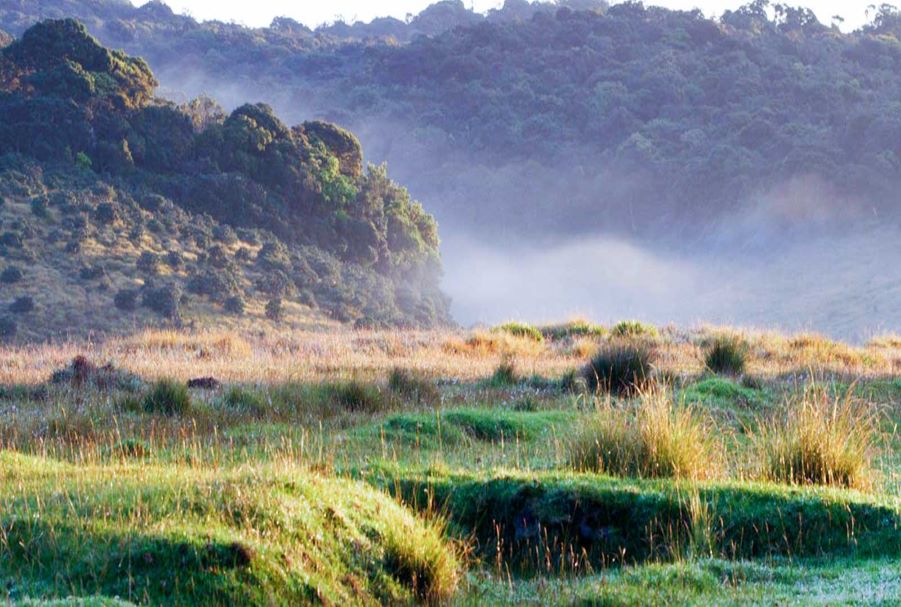Horton Plains national park is the highest plateau in Sri Lanka. It marks the southern boundary of the central highlands. The landscape of Horton plains is very different from the preconceived image of a tropical highland. The park views are dominated by panoramic rolling grass plains, with occasional peaks topped by patches of montane forests, which are blanketed by mists. The weather is not warm at all and rain is frequent. Everything is dewy, moist, and muddy. Every now and then, winds reach gale force, giving Horton plains a poetic beauty, usually seen only at bleak Scottish wildernesses. Nonetheless, it is very tropical. Most of its flora and fauna are endemic to Sri Lanka. Some of its forest covers receive the relict status, which makes it a treasure trove of biological history. 199 out of 353 vascular plants found at the plains are endemic. The critically endangered “Horton plains red slender Loris” is only found in this park, as the name suggests. Even the commonly found langur monkeys are identified as unique sub-highland subspecies, commonly known as the “bear monkey”. Among much unique wildlife, Dusky striped squirrel, giant squirrel, brown mongoose, rhino-horned lizard, pygmy lizard, and the black cheeked lizard are a few. The park has a healthy population of sambar deers frequently spotted grazing. It is also one of the few national parks in Sri Lanka where no vehicles are allowed inside. Instead, the visitors walk along with a set of foot trails that lead to various areas inside the parklands. The most popular and the easiest foot trail is called the world’s end–bakers falls round trail. Along this trail are the popular world’s end escarpment (884 meters), Baker’s falls, small world’s end, and chimney pool. The Horton plains national park hosts a unique eco-system and was designated a UNESCO world heritage site in 2010.
Trails in Horton Plains National Park
- World’s end – 4 to 6 hours
- Baker’s fall – 3 to 5 hours
- Kirigalpotta nature trail – 5 to 8 hours
- Thotupola Kanda – 2 hours
Trekking information about Horton Plains National Park
Opening and Closing Times
- 6.00 a.m to 6.00 p.m
Park Entrances
- Pattipola entrance
- Ohiya entrance
Trek Durations
- World’s end – Baker’s fall round trail – 4 to 6 hours
- Kirigalpotta nature trail – 5 to 8 hours
- Thotupola Kanda– 2 hours
Horton Plains Accessibility
- 4WD Vehicles, Buses, Vans, Lorries, and even Tuk-tuks can be driven to the main entrance at Farr Inn. Note that no vehicles are allowed beyond the Farr Inn visitor’s center. The treks begin from here on foot.
Access Roads to Horton Plains national park
- Nuwara eliya to Pattipola entrance via Ambewela
- Haputale to Ohiya via Boralanda
- Welimada to Ohiya via Boralanda
- Kalupahana to Ohiya (Only 4-WD
Major eco-systems inside Horton Plains National Park
- Montane Evergreen Forests
- Montane Upper Wet Patana Grasslands
- Montane Peat Bogs
- Rivers and water streams
- Natural water pools
- Waterfalls and spray zones
Other information – Horton Plains National Park
Status – National Park, Important Bird Area (IBA), UNESCO world heritage serial property (Central Highlands), Bio-diversity hotspot, Upper catchment area to Mahaweli, Kelani and Walawe rivers, Pre-historic archaeological site
Altitude – 1,950 metres to 2,389 metres
Annual Rainfall – 2,150 mm
Mean temperature– 150
Closest Towns to Horton Plains national park – Nuwaraeliya, Welimada, Haputale
Nearest Medical Care – Primary Medical Care Unit Ambewela
Major Attractions at Horton Plains national park – The world’s end escarpment, Baker’s falls, Kirigalpotta peak, Totapola peak, Bird Watching, Sambar deer, Cloud forests, Relict forests, Small world’s end escarpment, Chimney pool, Farr Inn Colonial Bungalow, Camping sites
Best time to visit Horton Plains national park – July to September and December to April
Useful Tips for Horton Plains national park Trek
- Early mornings are the best time to visit the park.
- Weather can change dramatically at Horton plains. It can get cold sometimes. Early morning frost is common.
- Tickets are issued at Pattipola and Ohiya entrances only.
- Ginihiriya and Mahaeliya wildlife bungalows are located inside the park and can be pre-booked by the department of wildlife for overnight stays. Campsites and dormitories are available as well. (Check https://dwc.lankagate.gov.lk/
homeAction.action for reservations.) - Take enough bottled water. Don’t forget to stay hydrated.
- Take care of yourself and others. Never stray off the guided trail. Always remember that you are in the wild.
- Avoid weekends and public holidays for your visit if possible. It might be a bit busy on such days.
- No polythene, plastic ware, alcoholic beverages, and cigarettes are allowed inside the park. Please keep your voice down as well.



